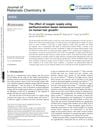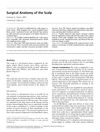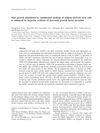Search
forLearn
5 / 9 resultslearn Stemoxydine
chemical from L'Oreal that encourages hair to enter growth phase
learn Minoxidil
An essential vasodilator with some anti-androgenic effects, has excellent safety record
learn Vascular Endothelial Growth Factor
learn Peppermint
herb and oil thought to stimulate skin and hair
Research
5 / 1000+ results
research The Effect of Oxygen Supply Using Perfluorocarbon-Based Nanoemulsions on Human Hair Growth
A new nanoemulsion increases oxygen for hair cells, leading to better hair growth.

research Surgical Anatomy of the Scalp
Understanding the scalp's five-layer structure is crucial for better surgical outcomes and fewer complications.

research Nailfold Capillaroscopy Alterations in Androgenetic Alopecia: A Cross-Sectional Study
Men with androgenetic alopecia, or hair loss, often have abnormal blood flow in their small blood vessels, which might be linked to inflammation and stress.

research Hair Growth Stimulated by Conditioned Medium of Adipose-Derived Stem Cells Is Enhanced by Hypoxia: Evidence of Increased Growth Factor Secretion
Low oxygen conditions increase the hair-growing effects of substances from fat-derived stem cells by boosting growth factor release.
research Understanding Human Aging and the Fundamental Cell Signaling Link in Age-Related Diseases: The Middle-Aging Hypovascularity Hypoxia Hypothesis
Improving blood flow and oxygen levels in middle age may help prevent age-related diseases.
Community Join
5 / 130 resultscommunity A Different Take on Curing MBP
Addressing hair loss by focusing on posture, blood flow, and craniofacial development. Methods include improving posture, cardiovascular activity, scalp massages, healthy diet, meditation, using minoxidil, and addressing craniofacial issues.
community Copper Literally Saved My Life (and My Baldness)
Oral copper supplementation significantly improved hair regrowth for someone who experienced severe hair loss after stopping minoxidil, suggesting copper deficiency might hinder minoxidil's effectiveness. The user now only takes copper and occasionally uses microneedling, recommending others to try copper if minoxidil alone isn't effective.
community Eating more iron has been helping my hairline
Improving iron levels, particularly ferritin, can help with hairline recovery. The user experienced hairline improvement by increasing iron intake through diet changes, without relying on minoxidil.
community A science based addition to your hair loss routine
Blocking the Mitochondrial pyruvate carrier and using aldose reductase inhibitors like Indian gooseberry and berberine may help with hair growth. Magnesium can also be added to increase NADPH.
community Atherosclerosis as cause of balding and treatment
Hair loss may be caused by calcification of capillaries in the scalp, restricting blood flow to hair follicles. A daily treatment regimen including high doses of Vitamins D and K, Magnesium, and Nattokinase could potentially decalcify these capillaries, improving blood flow and hair growth. However, some users warn against excessive Vitamin D intake and emphasize the need for medical consultation.